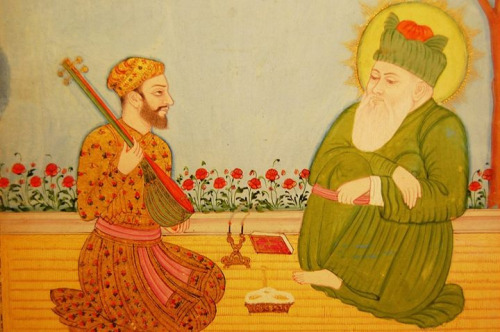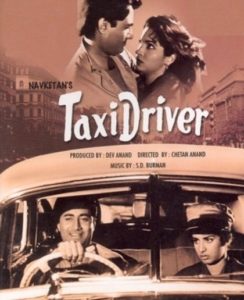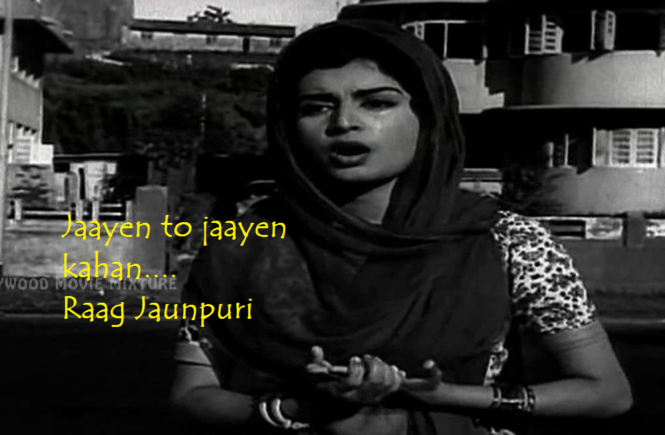Raaga Based Song of the Day: Jaayen to jaayen kahan…
Raag Jaunpuri, Tal Kaherava
We have completed twenty-seven days of Raaga Based Songs of the Day. Our first post in the series was titled ‘Raaga Based Song Of The Day #1’ and the song was a Mohammad Rafi and Lata Mangeshkar song from the 1970 Shakti Samanta movie Pagla Kahin Ka: Tum mujhe youn bhula na paoge. It is in Raag Jhinjhoti, Tal Kaherava.
Our twenty-seventh post was titled ‘Raaga Based Song Of The Day #27’ and the song was a Lata Mangeshkar song from the 1953 Nandlal Jaswantlal movie Anarkali: Muhabbat aisi dhadkan hai. It is in Raag Rageshri, Tal Kaherava.
This blog has a number of posts on Raaga based songs in Hindi movies titled similarly; for example: ‘The Best Raaga Based Songs in Hindi Movies – Raaga Bhimpalasi – Part II’.
In the last twenty-seven days of sharing Raaga based songs of the day, I have given you songs based on Raag Jhinjhoti, Gara, Bhimpalasi, Madhuvanti, Shivaranjani, Bihag, Pahadi, Sarang, Pilu, Bhairavi, Khammaj, Charukesi, Kalyan or Yaman, Desh, Malgunji, Kirwani, Kedar, Bageshri, Megh Malhar, Bhupali, Ahir Bhairav, Malkaush, Adana, Kafi and Rageshri.
Today, I give you a song in Raag Jaunpuri, Tal Kaherava.
However, first, lets take up the value added learning of today. Today, we shall learn about the History of Hindustani Music that we have been taking up for the last twenty-seven days:
Hindustani Music – also known as North Indian Classical Music or Shastriya Sangeet – started evolving sometime in the 12th century. Below, you would read about the person who devised Raag Jaunpuri: Amir Khusrow, and then you would understand how apt it is today to understand the history of Hindustani music.
Many of my friends routinely talk about how some of the best Hindi bhajans have been put together by Muslims. That’s exactly the beauty of Hindustani Music. It is because the tradition is pegged to Sufi music in India that was free from communal parochialism. The Hindu experts in music were called Pandits and Muslims as Ustaad and it was common for both of them to sing praises of one another’s deities.
Sufi composers like Amir Khusrow not just fused this music with Persian music but were able to bring into the courts of mughal emperors. Tansen, as we already know, was one of the navratnas in the court of Emperor Akbar and it was all because of his skills at music and raagas.
The fusion of Hindu music styles with Muslim in the courts of mughal rulers helped evolve various new forms or genre’s of music called Qawwali and Khayaal (Amir Khusrow has been credited with having devised Sufi Qawwali which fuses Persian melody and beat on a dhrupad like structure. A number of instruments (such as the sitar) were also introduced in his time).
All this while, the Hindu part of the fusion that finally emerged as Hindustani Music was in Sanskrit tradition. However, Guru Nanak (the father of Sikh religion) and Kabir (in the Bhakti Movement) used the popular language of the masses to popularise Hindustani music. And that’s why a study of Hindustani Music is not complete unless one understands about the Raag, Ragini, Putra system as enumerated in Sri Guru Granth Sahib, the holy book of the Sikhs. Jayadeva (11th century), Vidyapati (fl. 1375 CE), Chandidas (14th–15th century), and Meerabai (1555–1603 CE) were all part of the Bhakti Movement to which Guru Nanak and Kabir belonged and they were responsible for consolidating Hindustani Music.
Gradually, as I told you in one of my earlier posts, from the courts the Hindustani music came down to Gharanas. For example, in the late 15th century to early 16th century, Raja Mansingh Tomar of Gwalior encouraged shift from Sanskrit to Hindi as the language of classical songs. Many of our rulers were well versed in music (they used to be trained alike in fighting skills and music in Guru-Shshya tradition). Raja Mansingh was one of them. One of the musical forms called Dhrupad developed during his times. And, now you would recall why I penned Dhrupad to Gwalior Gharana when I told you about Gharanas (Please read: ‘Raaga Based Song Of The Day #17’).
The Nawab of Awadh, Wajid Ali Shah, is another name that springs to mind. His reign was between 13 February 1847 and 11 February 1856 and he was an exponent of Thumri. I have already given you his most famous composition in Raag Bhairavi (albeit sung by KL Saigal): Babul mora naihar chhooto hi jaaye when the British exiled him from his favourite city of Lucknow (Please read: ‘Raaga Based Song Of The Day #11’).
Today’s song, as I have already told you, is in Raag Jaunpuri, Tal Kaherava.
In our tenth post, that is, ‘Raaga Based Song Of The Day #10’, I had told you about the sources of name of Raagas; eg, deities: Kedar, Bhairavi, Gouri, Durga; and Tribal melodies: Ahir, Asavari, Gujari. And then came to the raagas that have been named after names of regions such as Pahadi (my place), Marwa, Bhupali and Jaunpuri.
Guess what? Jaunpuri (name of the place in Saurashtra as well as in Uttar Pradesh) belongs to the Asavari Thaat. Many experts feel that Jaunpuri is the same as Shuddha Rishab Asavari. What are the attributes of Asavari Thaat? It is full of tyaag (sacrifice) and renunciation and pathos. It is a late morning raaga.
Who was the first one to devise this raaga? Well, the raaga has been attributed to Amir Khusrow in the reign of Emperor Akbar. One of the benefits of Raag Jaunpuri is believed to be a cure from headache (as claimed by Pandit Jasraj).


The song is from the 1954 Dev Anand production (Navketan Films) Taxi Driver directed by his brother Chetan Anand and starring Dev Anand, his wife Kalpana Kartik (they secretly got married on the sets of the movie) and Johnny Walker. Lyrics of the songs of the movie were penned by Sahir Ludhianvi and since it was pre-1957 Pyaasa days, the songs were composed by SD Burman.
The song was sung by Talat Mahmood too. However, I am giving you the version by my favourite female singer: Lata Mangeshkar.
Please enjoy: Jaayen to jaayen kahan…
Jaaye to jaaye kahan
jaaye to jaaye kahan
samjhega kaun yahan
dard bhare dil ki juban
jaaye to jaaye kahan
samjhega kaun yahan
dard bhare dil ki juban
jaaye to jaaye kahan
O jaane waale daaman chhudake
mushkil hain jeena, tujhko bhula ke
o jaane waale
o jaane waale daaman chhudake
mushkil hain jeena, tujhko bhula ke
isse to hain, maut aasan
jaaye to jaaye kahan
samjhega kaun yahan
dard bhare dil ki juban
jaaye to jaaye kahan
Seene mein shole, saanso mein aahe
is zindagi se kaise nibhaye
seene mein shole
seene mein shole, saanso mein aahe
is zindagi se kaise nibhaye
har jajba hain veeran
jaaye to jaaye kahan
samjhega kaun yahan
dard bhare dil ki juban
jaaye to jaaye kahan
We have intended to learn about Raaga based music whilst we entertain ourselves with Raaga based songs. So, lets, once again, take stock of our collective learning so far:
- On the first day we learnt about the Raaga system devised by Pandit Vishnu Narayan Bhatkhande, which is the prevalent system in Hindustani Classical Music and based on ten Thaats.
- On the second day we learnt about Tal or Taal.
- On the third day we learnt about characteristics of Raagas that included Swar, Jati, Thaat, Arohana and Avarohana, Vadi, Samvadi and Pakad.
- On the fourth day, we learnt about Sargam.
- On the fifth day, we learnt about notations used in Indian classical music or simply Swar Lipi.
- On the sixth day, we learnt about the Ras (sentiments) that Raagas evoke.
- On the seventh day, we learnt about various types of Swar: Shuddha, Achal, Vikrut, Komal and Teevra.
- On the eighth day, we learnt the parts of a composition in Indian Classical Music.
- On the ninth day, we learnt the names of some of the popular instruments used in Indian Classical Music.
- On the tenth day, we learnt about the sources of names of Raagas.
- On the eleventh day, we learnt about why Bhairavi is the first raag to be taught to beginners and also why it is the last in a performance.
- On the twelfth day, we learnt about Khammaj Thaat.
- On the thirteenth day, we learnt about Tal Punjabi Theka or Sitarkhani.
- On the fourteenth day, we learnt about Alap.
- On the fifteenth day, we learnt about List of Raagas (Raagmala) in my favourite book: Sri Guru Granth Sahib.
- On the sixteenth day, we learnt about tips for raaga identification.
- On the seventeenth day, we learnt the basics of Gharana system.
- On the eighteenth day, we learnt about Filmi Sangeet.
- On the nineteenth day, we learnt about the commonest Tal in Raagas: Tintal.
- On the twentieth day, we learnt about the Kafi Thaat.
- On the twenty-first day, we learnt a little more in detail about the classification of Raagas.
- On the twenty-second day, we learnt the essential differences between Bhairavi and Bhairav.
- On the twenty-third day, we learnt a little more in detail about the Jati or Jaati of a raaga.
- On the twenty-fourth day, we learnt details of Thaat Bilawal, the most basic thaat in the Bhatkhande’s system of raagas.
- On the twenty-fifth day, we learnt about Tintal.
- On the twenty-sixth day, we learnt in detail about the Raaga – Samay linkage.
- On the twenty-seventh day, we learnt about Lehar.
- And today, on the twenty-eighth day, we learnt about the history of the Hindustani Music.
There is much more still to be learnt and enjoyed.
Please stay tuned!
